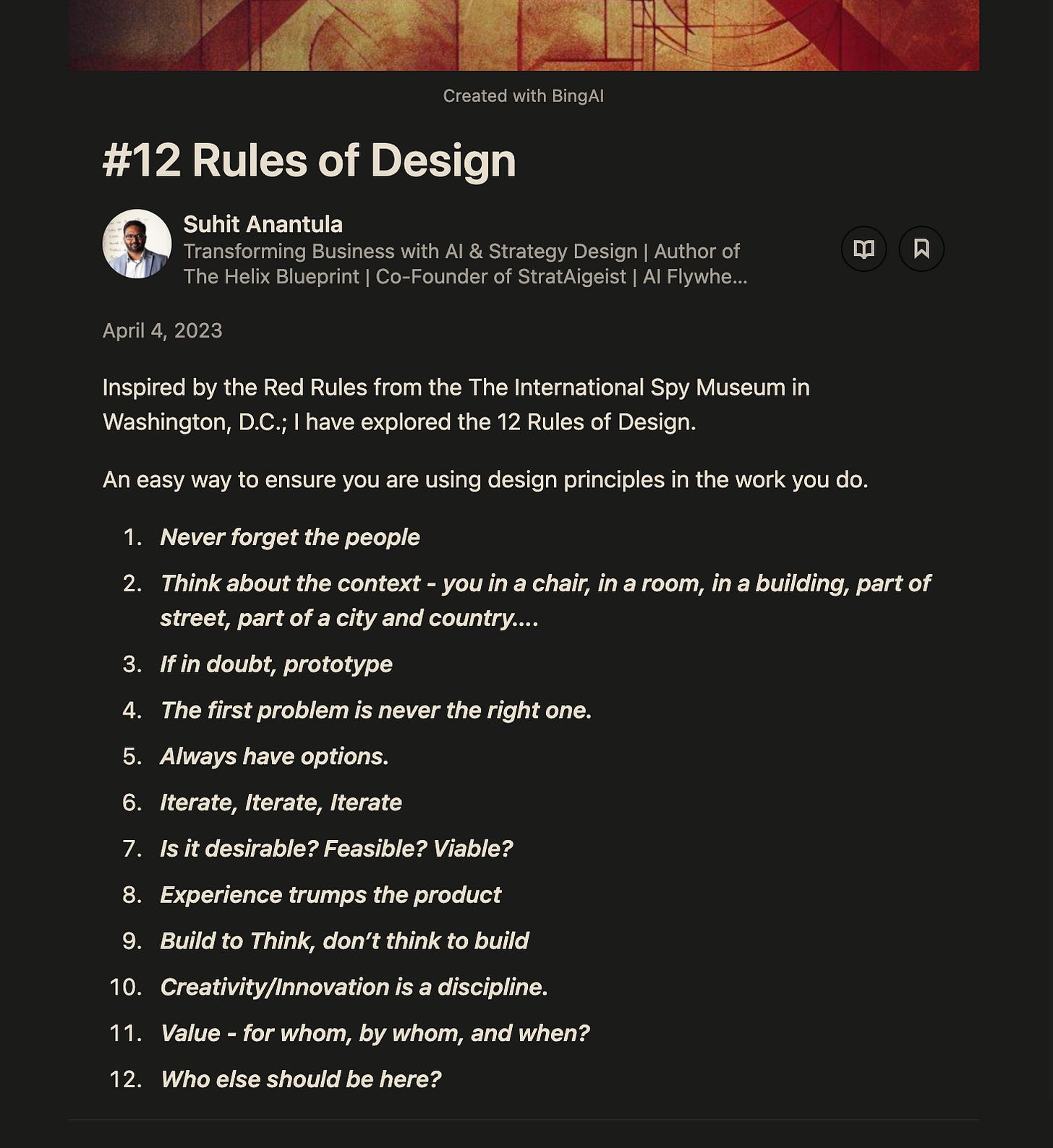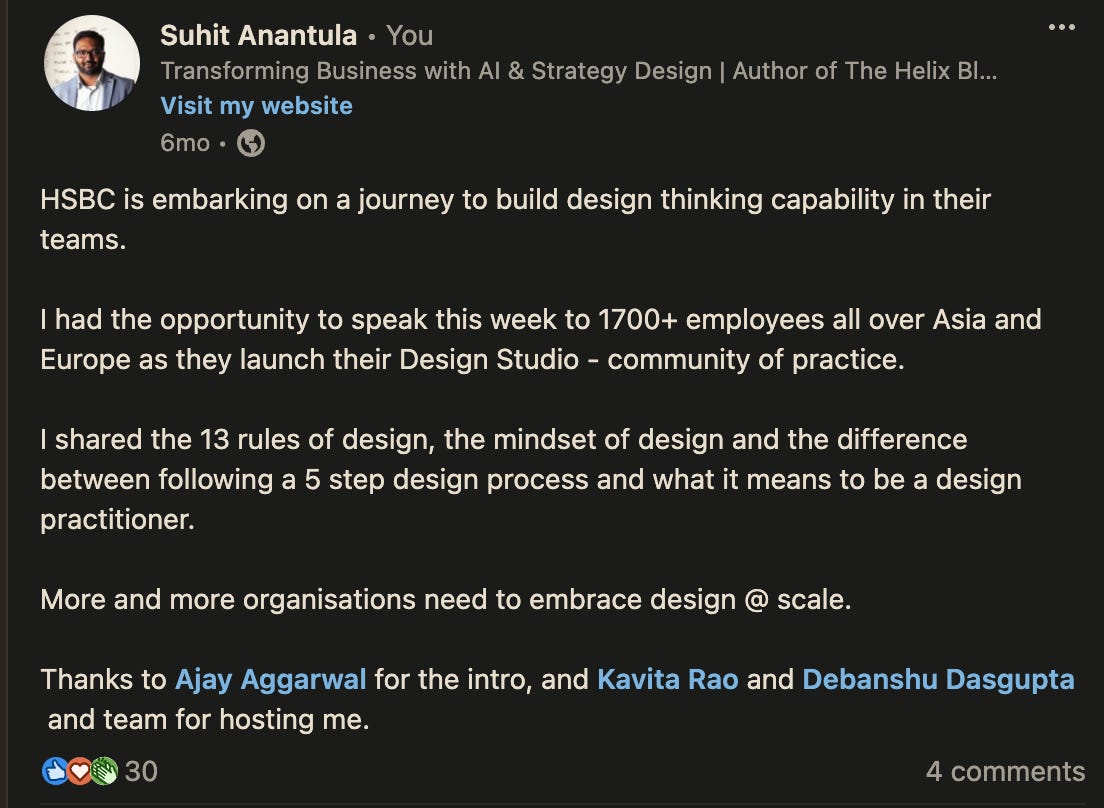Iterative Design: The Execution Engine Behind the Helix Blueprint
What if your strategy could adapt to complexity in real time, aligning innovation with impact? Enter the Helix Blueprint, a revolutionary framework designed for the age of uncertainty.
At its core lies Iterative Design, a continuous, flexible process that drives innovation and connects seamlessly to strategic objectives. This execution engine operates through five interconnected stages, providing a resilient and dynamic approach to design and strategy.
In my upcoming book, The Helix Blueprint, I explore how individuals—and through them, teams and organisations—can develop strategy and design capabilities, all augmented with AI. This book is the result of years of reflection, experimentation, and refinement, aiming to provide a practical yet transformative approach to modern strategy.
The Journey to Iterative Design
In April 2023, I set out to codify the knowledge I’d gathered over the years in design into 12 rules of design. The simplicity of this approach resonated with me and others. These rules, written in accessible language, struck a chord with the design community. In May, I had the chance to share them during the launch of HSBC’s Design Studio. The response was overwhelming—over 1,700 employees attended, and the enthusiasm reignited my passion to build these rules into something bigger.
However, as I worked on the book, the design rules began to feel incomplete. Without a unifying framework, they risked becoming disconnected ideas, difficult to follow or apply. Initially, I explored integrating them into existing frameworks like IDEO’s Human-Centred Design, Stanford’s Design Thinking, and the Double Diamond. But none of these frameworks felt quite right—they didn’t address the strategic and iterative nature of what I envisioned.
Introducing the Iterative Design Framework
Iterative Design combines the creativity and empathy of traditional design approaches with the strategic rigour of portfolio management and decision-making. It incorporates the principles of kaizen and lean thinking, focusing on continuous improvement while remaining adaptable to changing circumstances.
The framework unfolds across five interconnected stages:
1. Perceive → Understand
2. Perform → Create
3. Portfolio → Prioritise
4. Pause or Promote → Decide
5. Progress → Evolve
1. Perceive: Grounded in empathy, this stage is about understanding the problem or opportunity. Teams dive into user needs, research, and real-world insights to uncover hidden opportunities and define the scope for meaningful innovation.
2. Perform: Action and experimentation take centre stage. Teams brainstorm ideas, rapidly build prototypes, and test concepts, embracing failure as part of the learning process. This stage encourages exploration and discovery without constraints.
3. Portfolio: Not every idea will make it. This stage is a strategic checkpoint where ideas are curated, evaluated, and aligned with long-term goals. By prioritising high-impact ideas, organisations can focus resources effectively.
4. Pause or Promote: Unique to Iterative Design, this stage introduces a deliberate decision point. Teams assess whether to refine, proceed, or pivot based on new information. It emphasises strategic adaptability and reduces risk.
5. Progress: Innovation doesn’t end with implementation. The final stage focuses on learning, adapting, and evolving based on real-world feedback, ensuring designs remain relevant over time.
What Makes Iterative Design Unique?
The framework’s distinct advantages lie in its balance of structure and adaptability. Unlike traditional methods, Iterative Design:
• Embraces Strategic Flexibility: The Pause or Promote stage allows teams to adapt dynamically while staying aligned with long-term objectives.
• Maximises Impact: The Portfolio stage ensures resources are concentrated on ideas with the greatest potential for meaningful results.
• Champions Continuous Learning: The Progress stage fosters a feedback loop, keeping designs relevant and user-centred.
• Connects Strategy to Action: By blending design thinking with strategy, the framework ensures innovation translates into tangible outcomes.
How Does It Compare?
Using AI to augment my work, I asked ChatGPT to critique and compare this framework to others like IDEO’s and the Double Diamond.
Here’s what stood out:
Strengths:
1. A clear structure that flows logically from understanding to implementation and continuous improvement.
2. Strong emphasis on empathy and user insights in the early stages.
3. Flexibility in decision-making with the Pause or Promote stage.
4. A robust feedback loop that reinforces the iterative nature of design.
Areas for Growth:
1. Stage naming could be more consistent to maintain thematic clarity.
2. The Portfolio stage could benefit from additional clarity on its unique role.
3. Prototyping and testing could be emphasised more explicitly as critical steps.
And here is a visualisation of how my framework compares to other frameworks and individual unique points.
Iterative Design in Action
Let’s bring this to life. Imagine a healthcare team rethinking patient onboarding:
• In Perceive, they interview patients to uncover pain points.
• In Perform, they prototype multiple digital tools for smoother onboarding.
• The Portfolio stage evaluates the tools for potential impact and aligns it with organizational priorities.
• A Pause or Promote decision selects the one tool based on feedback before full implementation.
• Finally, in Progress, the team continues to gather insights, updating the tool to adapt to evolving needs.





